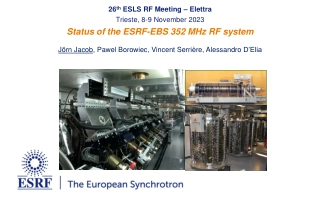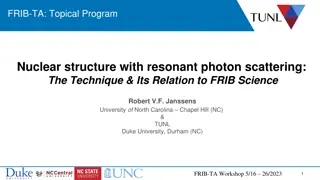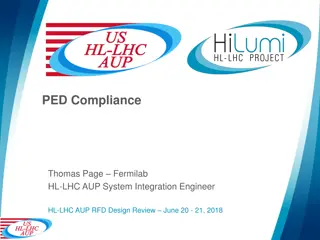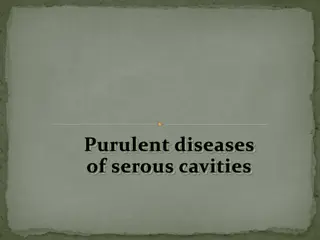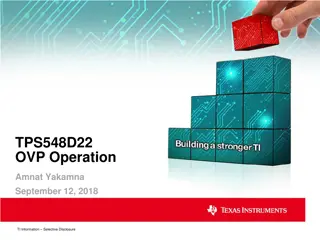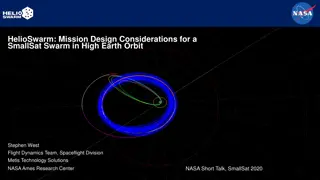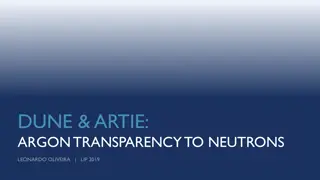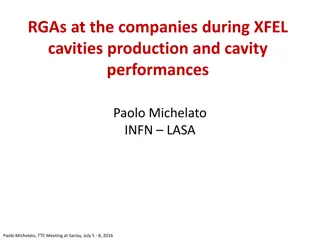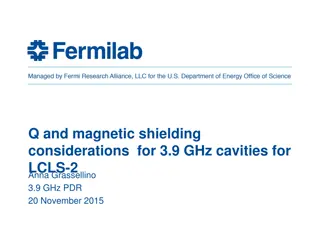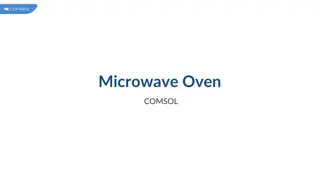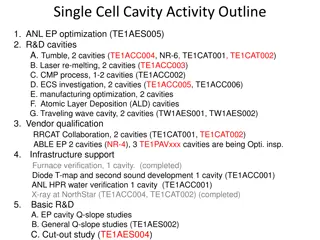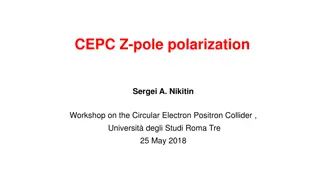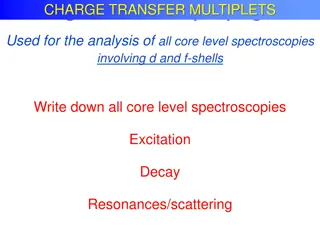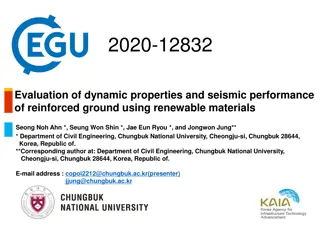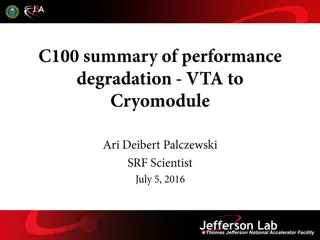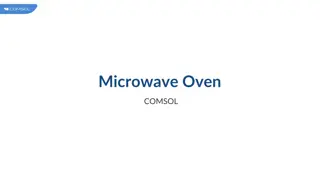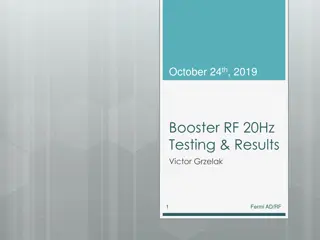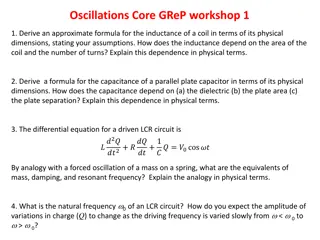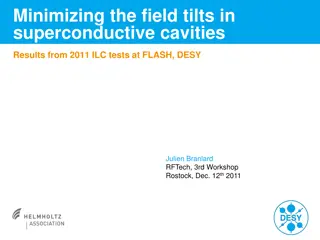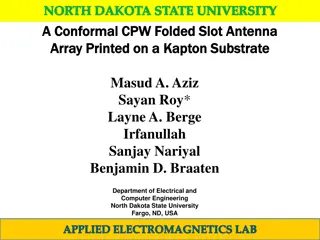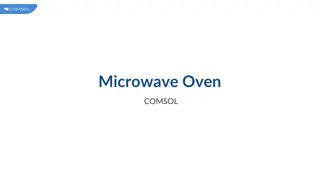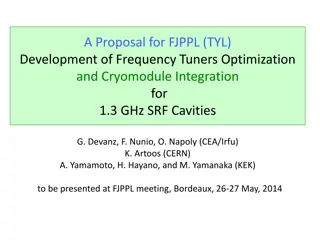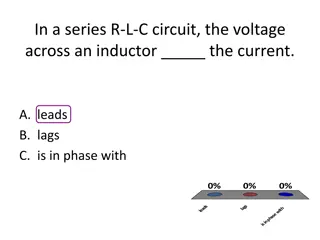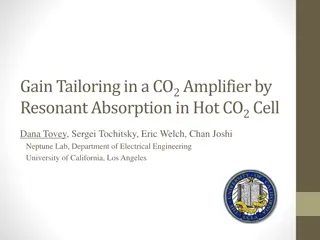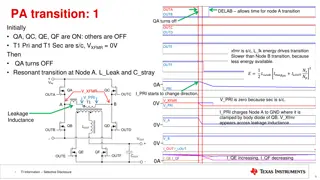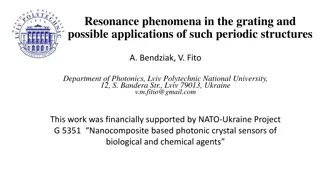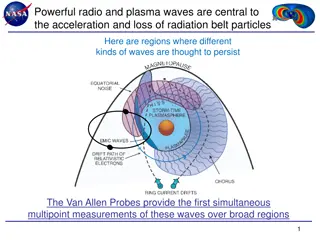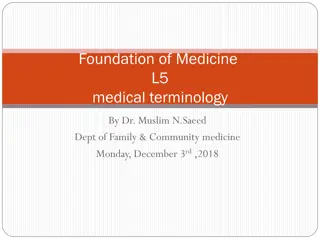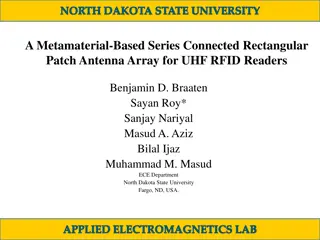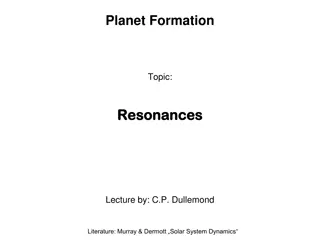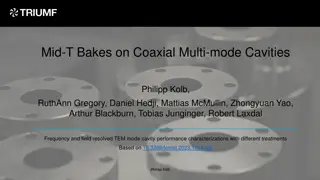Overview of ESRF-EBS 352 MHz RF System Upgrade at 26th ESL RF Meeting
The 26th ESL RF Meeting held at Elettra in Trieste discussed the status and upgrades of the ESRF-EBS 352 MHz RF system. The meeting covered topics such as the EBS RF layout, HOM damped cavities, RF ECO-Mode, ongoing RF projects, and the replacement of klystrons with SSAs for a 4th harmonic RF system
0 views • 16 slides
Cisco Systems Fault Managed Power Portfolio Overview
Cisco Systems offers an industry-leading Fault Managed Power (FMP) patent portfolio comprising 24 active assets across seven INPADOC families. The portfolio includes patents supporting fault-managed power systems, PoE deployments, DC power distribution, DC-DC conversion, and HVDC connectors. The FMP
4 views • 4 slides
Understanding Gravitational Anomalies and Interpretation Challenges
Gravitational anomalies pose an inverse problem in determining characteristics of underlying bodies. Surface gravity values provide insights into geometric shape, dimensions, density contrast, and depth. Interpreting anomalies requires integrating gravimetric analysis with other geological data. Cal
5 views • 62 slides
Nuclear Structure Investigations with Resonant Photon Scattering at FRIB-TA Workshop
Explore nuclear structure using resonant photon scattering at the FRIB-TA Workshop. The High Intensity Gamma-ray Source facility enables research on photonuclear reactions, spin and parity determinations, and selective investigation of nuclear states. Learn about the technique's potential impact on
2 views • 33 slides
Overview of PED Compliance Requirements for RFD Crab Cavities Fabrication at FNAL
The process of ensuring PED compliance for RFD crab cavities fabricated by FNAL involves a review of EN and ASME Codes, with additional requirements set by CERN HSE. A formal agreement is being finalized, with a document defining essential safety requirements, risk assessment, and more. Additional r
5 views • 13 slides
Innovative Superconducting Cavities Research Project Overview
This project, funded by the European Union's Horizon 2020 program, focuses on innovative superconducting cavities coated with superconducting films. Objectives include optimizing production procedures, testing prototypes, and reducing costs. Tasks involve coordination, strategy development, and achi
2 views • 9 slides
Purulent Diseases of Serous Cavities: Understanding Purulent Pleurisy and Empyema Pleurae
Purulent diseases of serous cavities, specifically purulent pleurisy and empyema pleurae, are marked by the secondary nature of inflammation in the parietal and visceral pleura. The classification details the etiology and clinical variations, while the pathogenesis explains the development from vari
0 views • 31 slides
NCP4390/NCV4390 Secondary Side Synchronous LLC Controller
The NCP4390/NCV4390 is an advanced secondary side controller for LLC resonant converters with Synchronous Rectification (SR). It features current mode control based on charge control, dual-edge adaptive dead time control, and is an upgrade of FAN7688. The controller offers benefits like excellent tr
1 views • 6 slides
Advanced Operation of TPS548D22 with OVP Functionality
This detailed content presents the operational intricacies of TPS548D22 with OVP function, including setup specifications, fault-triggered actions, shutdown mechanisms, threshold behaviors, and minimum on-time considerations. The process involves orchestrated switching between FETs to regulate VOUT
0 views • 7 slides
Mission Design Considerations for a SmallSat Swarm in High Earth Orbit
HelioSwarm presents a mission concept involving a propulsive ESPA hub deploying smallsat nodes in a lunar resonant orbit. The swarm design requirements focus on complex hub-relative trajectories for each node, emphasizing high-rate data crosslinks and measurement-optimized tetrahedra formation. Smal
6 views • 7 slides
Transistor Tuned Amplifiers: Operation and Analysis
Transistor tuned amplifiers consist of a parallel tuned circuit as the collector load, amplifying a specific frequency while rejecting others. The resonant frequency of the tuned circuit is crucial for amplification. A high Q circuit offers maximum voltage gain at the resonant frequency but decrease
0 views • 30 slides
Status Update on GRANIT Spectrometer at Les Houches (August 19, 2024)
GRANIT aims to increase observation time of neutrons in gravitational states and enhance precision of measurements. Details about the clean room, UCNs hunting, and progress made in 2010 are outlined, emphasizing the need for system reliability and improvement. Significant steps have been taken towar
0 views • 34 slides
Exploring Neutrons and Argon in the DUNE and ARTIE Experiments
Detailed overview of experiments like DUNE and ARTIE focusing on the use of liquid argon time projection chambers for studying neutron interactions. Discussions include Pulsed Neutron Source calibration, scattering length measurements, ARTIE setup for resonant transport interactions, and current sim
2 views • 10 slides
Insights into XFEL Cavities Production and Vacuum System Challenges
The discussions at TTC Meeting in Saclay shed light on companies' experiences during XFEL cavities production, revealing operational challenges related to vacuum plants and RGAs. The use of different firm RGAs resulted in distinct effects on RGA behavior, affecting signal/noise ratio and calibration
0 views • 24 slides
Understanding Microwave Tubes and Klystron Technology
Microwave tubes play a crucial role in high-frequency applications due to their efficiency and operating principles. Conventional tubes face limitations beyond 100MHz, while efficient microwave tubes utilize electron velocity modulation for power conversion. Klystron tubes, such as Reflex Klystron,
4 views • 19 slides
Understanding Magnetic Shielding Considerations for 3.9 GHz Cavities
This document discusses Q and magnetic shielding considerations for 3.9 GHz cavities used in the LCLS-II project, highlighting the unique behavior observed in nitrogen-treated cavities. The study delves into the improved Q values and field dependence of quality factors, challenging traditional niobi
0 views • 10 slides
Modeling Heating Process in Microwave Oven
This model simulates the heating process in a microwave oven by analyzing the distributed heat source through electromagnetic and heat transfer simulations. It evaluates the microwave power distribution, absorption rate in the potato, and temperature changes over time. The results highlight the reso
0 views • 13 slides
Single Cell Cavity Activity Overview
The Single Cell Cavity Activity includes ANL EP optimization, R&D cavities for various processes such as tumble, laser re-melting, CMP, ECS investigation, and manufacturing optimization. There are also activities related to Atomic Layer Deposition (ALD) cavities, traveling wave cavities, vendor qual
0 views • 4 slides
Photoproduction of Pionic Atoms at the Gamma Factory: Research Overview
Research conducted by V. V. Flambaum, J. Jin, and D. Budker at the Gamma Factory (GF) on photoproduction of pionic atoms is detailed in this content. It explores the formation of pionic atoms with negative pions orbiting the nucleus in a hydrogen-like system, emphasizing strong interaction effects a
0 views • 11 slides
Radiative Polarization Techniques in CEPC for Precision Measurements of Z-Pole Mass
Prof. Jie Gao led discussions on the CEPC polarization program, focusing on obtaining transverse and longitudinal polarizations. The use of special wigglers to enhance the polarizing effect of the magnetic field was highlighted, reducing the time needed for radiative self-polarization. Strategies to
0 views • 22 slides
Core Level Spectroscopies in Charge Transfer Multiplet Program
Core level spectroscopies in the Charge Transfer Multiplet Program are essential for analyzing d and f-shells in various spectroscopic techniques involving excitation, decay, resonances, and scattering. These spectroscopies include X-ray spectroscopies, electron spectroscopies, and resonant spectros
0 views • 69 slides
Evaluation of Dynamic Properties and Seismic Performance of Reinforced Ground Using Renewable Materials
Improvement of seismic performance through improved dynamic properties of ground using renewable materials like cement and biopolymer is crucial for reducing earthquake-induced structural damage. This study conducted resonant column tests to assess the enhanced dynamic properties of soil and utilize
0 views • 9 slides
Quality Control and Testing Procedures for Superconducting Radiofrequency Cavities
The presentation highlights the rigorous processes involved in qualifying superconducting radiofrequency (SRF) cavities for high-performance applications. Each cavity undergoes a detailed qualification process, including BCP treatment, electropolishing, and high-pressure rinsing, to ensure optimal p
0 views • 18 slides
Modeling Microwave Oven Heating Process
This model simulates the heating process in a microwave oven, analyzing the distribution of heat through a stationary electromagnetic analysis and transient heat transfer simulation. It showcases the redistribution of heat in food as it absorbs microwave energy, with detailed evaluations of power ab
0 views • 10 slides
Booster RF 20Hz Testing & Results Summary
The Booster RF 20Hz Testing & Results conducted on October 24th, 2019 involved thermal scans and testing of power supplies and cavities for running at 20Hz. The testing highlighted concerns with power distribution and the potential for bus bars to get hot under load, requiring further investigation.
0 views • 30 slides
Understanding Inductance and Capacitance in Electric Circuits
Explore the derivation of inductance and capacitance formulas in terms of physical dimensions and learn about the dependencies on coil area, number of turns, dielectric, plate area, and plate separation. Understand how inductance relates to magnetic flux and coils while capacitance is linked to char
0 views • 16 slides
Minimizing Field Tilts in Superconductive Cavities: 2011 ILC Tests at FLASH
Understanding the importance of achieving flat gradients in superconductive cavities, the 2011 ILC tests at FLASH led by Julien Branlard focused on minimizing field tilts. Various solutions and test approaches were explored to address the issue, with results indicating the impact of cavity tilt and
0 views • 25 slides
Conformal CPW Folded Slot Antenna Array on Kapton Substrate at North Dakota State University
The study conducted at North Dakota State University involves the design and analysis of a conformal CPW folded slot antenna array printed on a Kapton substrate. The research covers topics such as introduction, background, design guidelines, and measurement results. Various parameters of the antenna
0 views • 19 slides
Understanding Heating Process in Microwave Oven
Model simulation showcasing the heating process in a microwave oven through electromagnetic analysis and transient heat transfer. Explore how heat redistributes in a potato placed inside the oven at 2.45 GHz frequency. Analyze the absorbed power, microwave distribution, and temperature evolution ove
0 views • 10 slides
SRF Cavities and Cryomodules Workshop Details
This workshop provides information on SRF cavities and cryomodules, bringing together experts to address key engineering decisions, microphonic issues, and noise reduction techniques. Attendees can expect engaging sessions, networking opportunities, and valuable insights into the latest developments
0 views • 11 slides
Development of Frequency Tuners Optimization for SRF Cavities
Frequency tuners are crucial for adjusting the fundamental frequency of superconducting RF cavities to counteract detuning effects. The proposal discusses the importance of tuners, their operational mechanisms, and the challenges in achieving high reliability for efficient cavity operation. Various
0 views • 14 slides
Understanding R-L-C Circuit Voltages and Power Characteristics
Exploring the behavior of voltages across components in R-L-C circuits and discussing the relationship between voltage and current phases, as well as the concept of power in AC circuits. Additionally, the distinction in resonant frequencies between series and parallel R-L-C circuits is addressed.
0 views • 6 slides
Optimizing Gain Tailoring in CO2 Amplifiers for Laser Applications
The research focuses on enhancing gain tailoring in a CO2 amplifier through resonant absorption in hot CO2 cells, crucial for applications such as generating light channels in air, particle acceleration, and laser fusion. The study involves amplification of short pulses, CO2 laser gain spectra analy
0 views • 9 slides
Understanding Passive/Active Resonant Transition in Power Amplifier
DELAB allows time for node A transition in PA with OUTA and OUTB. The transition is slower than AP transition, making ZVS harder to achieve across load range due to less energy. Transition time is shorter at higher currents, and the controller can adjust delays adaptively. Remember, the conditions f
0 views • 12 slides
Resonance Phenomena in Grating Structures and Applications
Resonance phenomena in grating structures, such as dielectric or metal gratings on substrates, offer sensitive elements for detecting biological and chemical agents. The sensitivity of these structures is described by equations relating to resonant wavelength changes and the refractive index of inve
0 views • 20 slides
Unveiling the Role of Radio and Plasma Waves in Particle Acceleration
Radio and plasma waves play a crucial role in the acceleration and loss of radiation belt particles. The Van Allen Probes provide groundbreaking multipoint measurements of these waves in various regions, shedding light on phenomena such as chorus waves and resonant wave acceleration. Strong correlat
0 views • 8 slides
Major Body Systems and Cavities in Human Anatomy
Understanding the major body systems, including skeletal, muscular, cardiovascular, lymphatic, immune, respiratory, digestive, urinary, nervous, endocrine, reproductive, integumentary, and special senses systems, as well as the dorsal cavity comprised of the cranial and spinal cavities. Each system
0 views • 20 slides
Metamaterial-Based Series Connected Rectangular Patch Antenna Array for UHF RFID Readers
The metamaterial-based UHF RFID reader antenna array comprises features like rectangular patches, inter-digital capacitors, tuning stub, and a series fed array. The prototype dimensions and substrate details are provided along with resonant frequency observations. Test results include S-parameters o
0 views • 15 slides
Understanding Resonances in Planet Formation
Resonances play a crucial role in planetary systems, where characteristic frequencies align to produce dynamical consequences. Mean motion resonances, spin-orbit resonances, and secular resonances are key examples influencing planetary dynamics. Explore resonant angles, resonant arguments, and examp
0 views • 17 slides
Frequency and Field Resolved TEM Mode Cavity Performance Characterizations
This study focuses on the performance characterizations of TEM mode cavities with different treatments, including mid-T bakes and other processes. Investigations include the impact on Q0 and Eacc, sensitivities to magnetic fields, and strategies for improving medium field Q slope. The research aims
0 views • 19 slides
